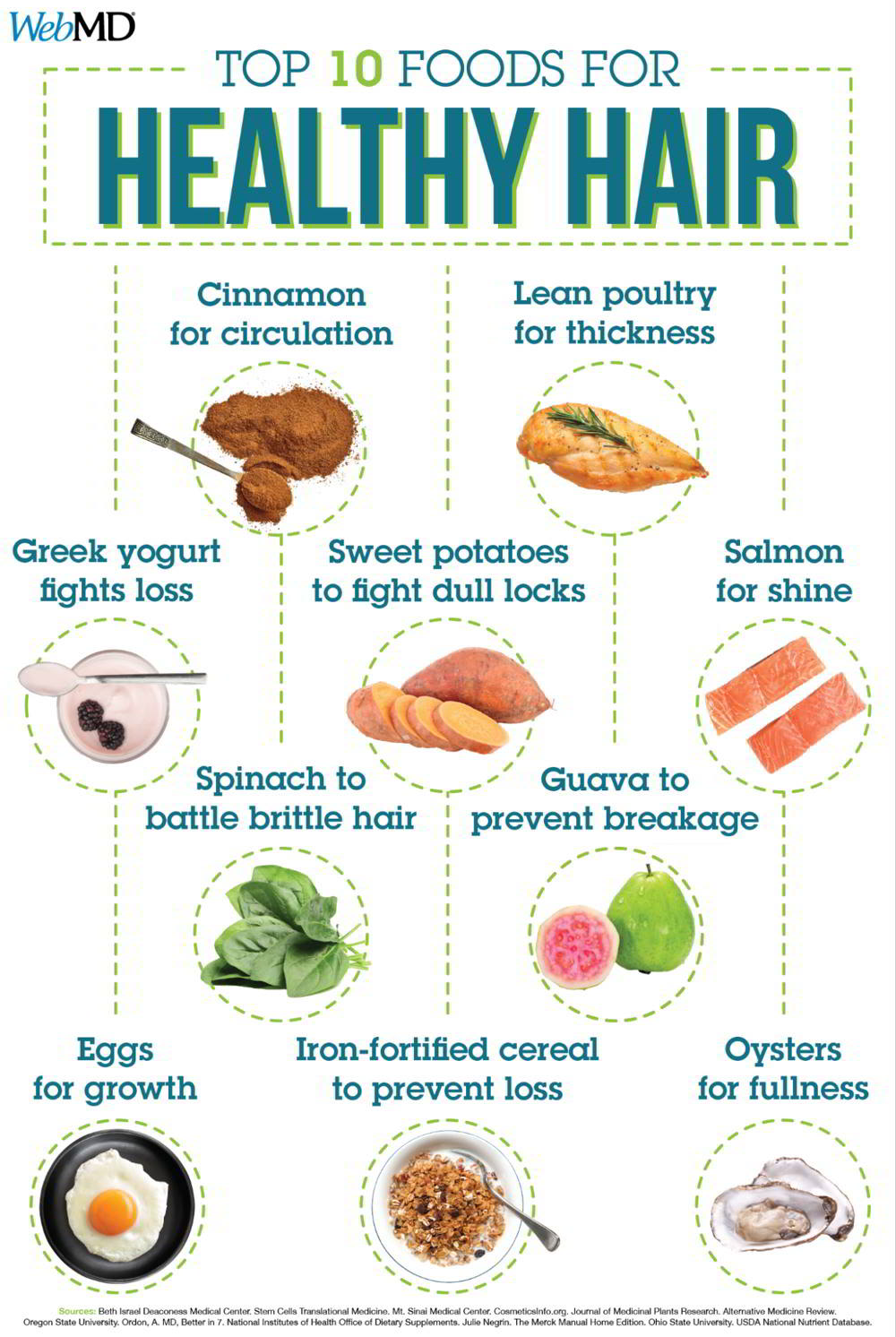Male Hair Loss Treatments
The most common hair loss condition for men is Male Pattern Baldness (MPB). This condition can also be referred to as androgenic alopecia and genetic hair loss. This results in the gradual loss of hair, ultimately resulting in balding. The pattern of hair loss can typically be seen at the front of the head and the middle spreading towards the top area of the head.
What is hair mesotherapy?
Mesotherapy is an alternative treatment that helps to cure baldness in both males and females by reducing hair loss, promoting hair growth and slowing male pattern baldness. It is a process which regulates the proteins, vitamins and other nutrient levels and growth factors in the scalp of the patient suffering from balding. This is done by injecting in the least painful way.
How is mesotherapy performed?
A hair mesotherapy session lasts 10-15 minutes. The frequency of the sessions will depend on each patient’s particular situation and the professional doctor’s diagnosis. This may vary between a session every other week for 5 weeks followed by 5 monthly sessions, a session every other week for 10 sessions, or 10 monthly sessions.
Effectiveness and Contraindications of Hair Mesotherapy
Hair mesotherapy is a very effective treatment, for both men and women with different hair loss problems.
It promotes regeneration and encourages hair growth; it’s a very useful option with zero risk for patients because it is performed on superficial levels of the dermis
After each session patients have to avoid wet places such as saunas or pools and it is advisable to protect the area treated from solar radiation.
Hair mesotherapy is not recommended for pregnant women or breastfeeding mothers, individuals underage and people undergoing chemotherapy.
This treatment is recommended for everyone who wants hair with more vitality, volume, shine, resilience, and quality.
One of the great things about hair mesotherapy is that it is perfectly compatible with hair transplantation. And what’s more, it’s compatible with other treatments done at St Mary’s clinic, such as PRP (Platelet rich plasma)
Benefits of hair mesotherapy
Hair mesotherapy has four major benefits :
- Prevents hair loss
- Maintains the strength of hair
- Nourishes the scalp providing the growth factors needed for healthy hair
- It promotes scalp regeneration,
- Stimulates the growth of more hair
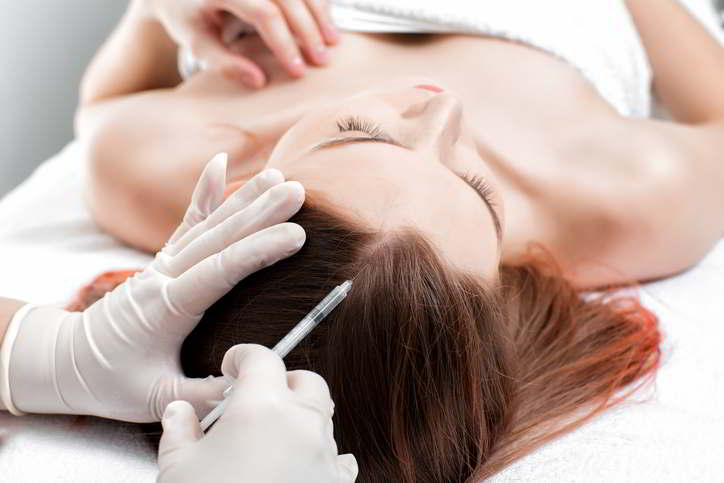
Platelet rich plasma
What is a PRP treatment and what does it engage ?
Platelet rich plasma, more commonly known as PRP is an exciting non-surgical therapeutic option. This treatment involves the drawing of blood, where the protein rich plasma is extracted in a high concentration through centrifugation and injected in areas in order to bring about their desired effect.
Step 1 Your blood is drawn — typically from your arm — and put into a centrifuge (a machine that spins rapidly to separate fluids of different densities).
Step 2 After about 10 minutes in the centrifuge, your blood will have separated into in three layers:
- platelet-poor plasma
- platelet-rich plasma
- red blood cells
Step 3 The platelet-rich plasma is drawn up into a syringe and then injected into areas of the scalp that need increased hair growth.
Benefits of PRP
PRP is very useful for every type of alopecia, especially for female alopecia and alopecia areata, as well as for post-chemotherapy alopecia. PRP has become one of the most frequently used treatments against hair loss due to its regenerative potential.
PRP is recommended for every patient, regardless of the degree of hair loss and also for patients before or after undergoing hair transplant.
Are PRP treatments painful?
Clients who have undergone the procedure describe any sensations felt to be bearable and only feel a mild discomfort rather than actual pain. Discomfort is kept to a bare minimum by advanced techniques used by our experienced team.
How frequent does PRP need to be carried out?
The expected results are obtained through repetition of the PRP treatment every 3-4 weeks for a total of 2-4 sessions in a year, while other patients choose to do the treatment every 6 months to 1 year thereafter, depending on the individual patient’s response and results.The amount of treatments required to obtain the desired result differs from one person to another depending on the medical diagnosis and the eagerness of a patient.
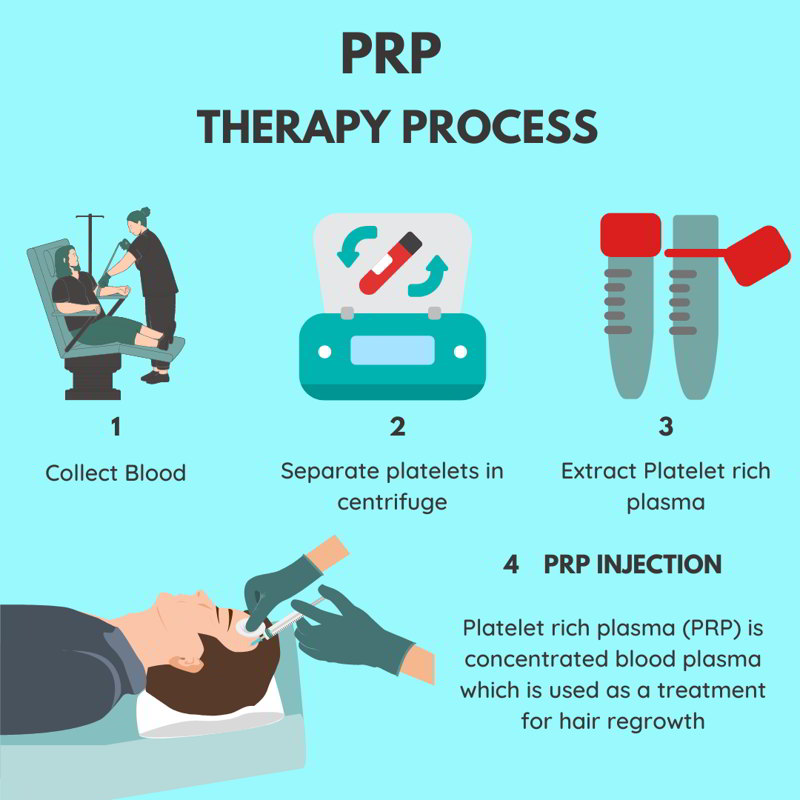
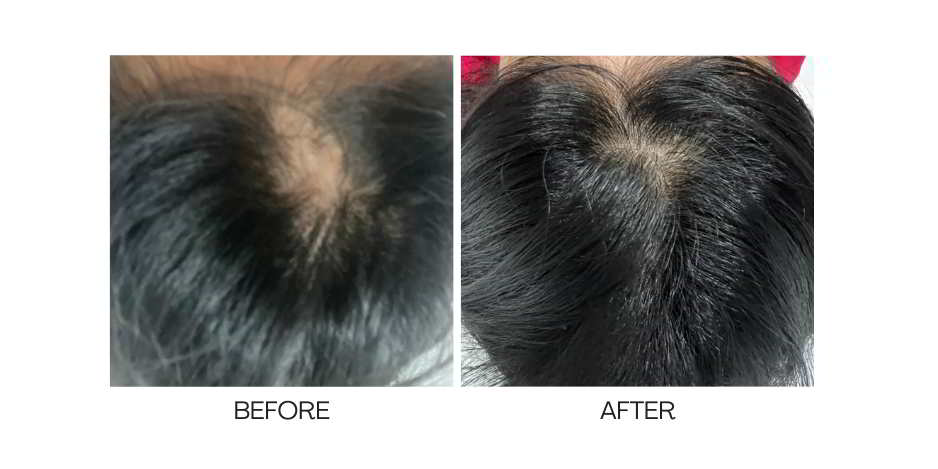
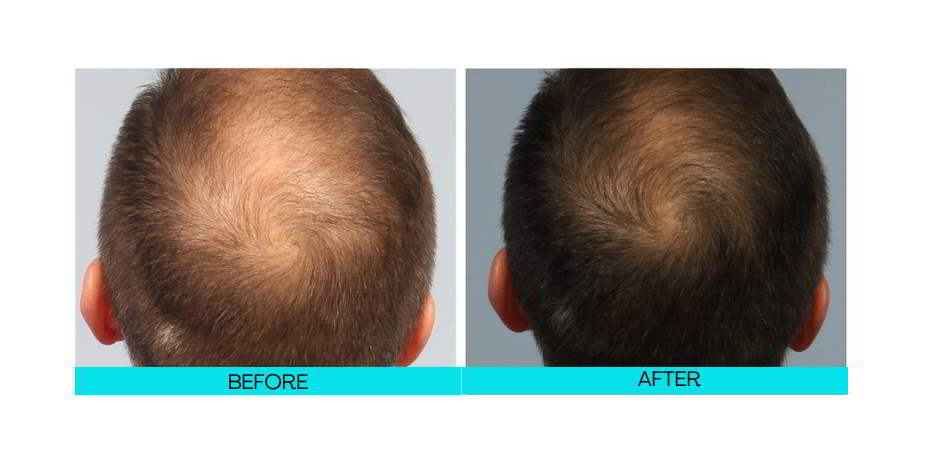
How long does it take to see results?
Substantial results are usually seen within 8-12 weeks, this differs from one person to another. After 8 weeks significant improvements are seen in most patients.
What results to expect?
Usually patients observe a decrease in hair shedding, followed by early regrowth and increased strength and length of hair. The general consensus is that receiving PRP treatment every six months to 1 year on a long-term basis are optimal for continuing to stimulate the growth factors and stem cells that are associated with regrowth and stopping hair from falling out.
The image above shows the progress of a patient after 4 PRP sessions done in one month intervals for 4 months. Result was seen after 6 months from the first day of treatment.
Stem cell therapy for hair growth using adult Derived Stem Cell Therapy as a Non-surgical
Hair Loss Treatment
What is Stem Cell Therapy?
During the stem cells treatment adult stem cells are derived from the patient’s own body fat cells. As these exist throughout the body and are mostly abundant (and accessible).
Stem cells are unspecialized cells that maintain and repair tissues, holding a unique potential to develop into many different types of cells. During the hair regeneration process stem cells are injected into the scalp in order to exert a paracrine effect by inducing hair cells to become more active.
This treatment is an outpatient procedures conducted in a sterile with in our clinic, utilizing state-of-the-art equipment. Under local anesthesia, the process is relatively painless and safe with minimal downtime.
Results
Results vary from patient to patient. Stem Cell therapy is approved and safe. It has many demonstrated treatment protocols for numerous medical disorders. Stem cell therapy is new to hair restoration surgery however very good results have been recorded. This procedure is typically used for those patients who are not surgical candidates because they are too young, or are in the early phase of hair loss. Women who suffer from hair loss are also good candidates when hair surgery is not desired or if not enough donor hair exists for hair transplantation.
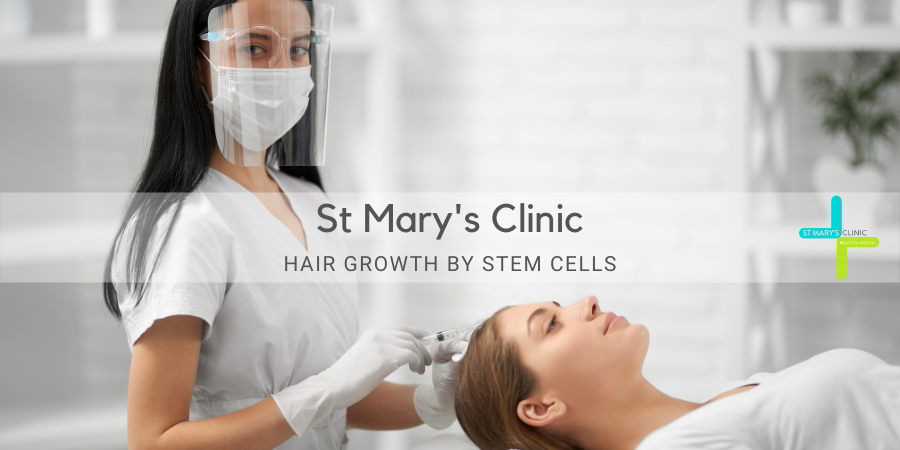
Stem Cells Malta
Laser Hair Growth therapy
LHGR – Laser Hair Growth Regeneration
Laser Hair Growth Regeneration Therapy also referred to as Red Light Therapy is a process whereby the laser irradiates photons into scalp tissues. These photons are absorbed by weak cells to encourage hair growth.
It is widely accepted that the procedure is safe, tolerable, and less invasive than hair transplant surgery. The theory of laser treatment for hair loss is that the low-dose laser treatments invigorate circulation and stimulation that encourages hair follicles to grow hair. Topical hair growth treatments have been found to significantly improve the overall thickness and fullness of your strands. As the hair-regrowth benefits of laser light therapy continue to gain notoriety, laser is a non-invasive, non-surgical therapy to correct the common symptoms of hair loss, including thinning hair, receding hairlines and male and female pattern baldness.
Unlike their LED light counterparts, lasers have a higher energy density that allows for more intense and effective stimulation of the hair follicles. Stocked with laser-emitting diodes that are strategically placed to fully and evenly cover your scalp, the Laser Hair Growth Regeneration devices reactivate your hair’s natural growth pattern by promoting blood circulation and collagen production, resulting in increased hair growth and thickness.
A 2013 studyTrusted Source of 41 males ages 18 to 48 found that laser hair treatment provided a 39 percent increase in hair growth over a period of 16 weeks.
What are the positives of laser treatment for hair loss?
There are a number of reasons that advocates cite to encourage participation in the procedure, including:
- it’s noninvasive
- it’s painless
- there are no side effects
- it increases hair strength Increases ATP (Adenosine Triphosphate) which provides energy to the hair follicle
- Lessens inflammation of the hair follicle, which contributes to the miniaturization process that comes with hair loss
Combination Therapy
Low hair growth regeneration therapy is combined with an individual plan involving herbal medication and prescription medication as well as PRP and mesotherapy where required depending on the case. For a specialised hair growth regeneration plan, contact us today for a consultation with one of our resident specialists.
The results achievable can be seen below. Results cannot be guaranteed as the extent of hair growth is unique to each case. The reaction of the body to treatment is key for the overall result.
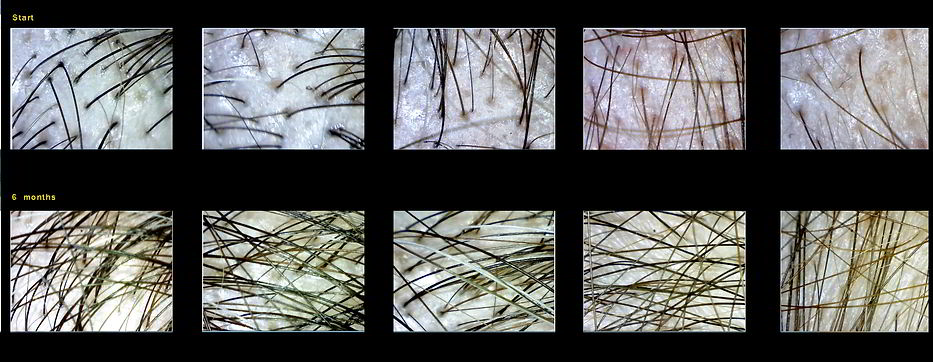
DHT
Laser hair Growth Regeneration therapy can combat the conversion of testosterone to dihydrotestosterone (DHT), which is the leading cause of pattern hair loss.
Increases Blood Circulation
This non-Invasive therapy also increases the capillary size, which is found just beneath the hair follicle. This increases blood circulation which provides a greater flow of vitamins, nutrients and oxygen directly to the hair follicle, encouraging growth.
Hair Regeneration
LGHR therapy has found to stimulate cell proliferation at the base of the follicle to enable it to enter the active growth (anagen) phase and rapidly reproduce new cells to grow new hair. This new thicker hair replaces the thin, fine wispy hairs of pattern hair loss.
Stimulation
Another advantage of Laser therapy is that it stimulates normal return of protein levels which is a key factor of thinning hair and hair loss. This growth in protein synthesis improves cell permeability, allowing the cells to accept nutrients and oxygen.
Scalp micropigmentation (SMP)
What is scalp micropigmentation?
Scalp Micropigmentation is a non-invasive treatment that uses detailed micro-needles to deposit pigment into the scalp. The result creates the appearance of tiny hair follicles that help thicken and restore the look of fuller hair by accurately replicating your own natural hair follicles and hair color. If you are starting to thin, recede, or if you are completely bald, we can give you the look of a short buzz cut. The main objectives of the treatment are modifying, correcting, embellishing and balancing certain features semi-permanently by implanting pigments in the skin.It is an excellent choice to hide scars on the scalp, and simulate fuller hair and a shaved head in patients with severe or total alopecia. The density added to the thinning areas creates an undetectable illusion of thicker, stronger hair. Scalp pigmentation requires little to no continued maintenance and carries no strict lifestyle or daily restrictions.
When administered by a trained and licensed specialist, the Scalp Micropigmentation treatment can restore receded hairlines, thicken remaining hair, camouflage transplant scarring, and create the look of close densely packed hair.
What are the three possible results?
Results are usually excellent, since micropigmentation is a very advanced and well-developed technique so it is almost imperceptible. It can be used in patients with total or partial hair loss.
The expected result in some patients is a buzz cut look or shaved look, as if their scalp was naturally shaved. This look can be achieved in patients with areas completely bald due to hair loss.
Other patients who have a small amount of hair want it to look fuller.
Some other patients may want to hide scars from prior hair micro-transplants or from other types of surgeries in the scalp.
It is also important to take into consideration color intensity, which will depend on the area we are dealing with and on whether we want to mark some dots more than others.
To create the most natural appearance possible, on average, patients receive two to three treatments spaced out 10-14 days between each session, followed by “touch ups” every 4-6 years, if needed.
Scalp Micropigmentation is sometimes referred to as a Hair Tattoo, Head Tattoo, Scalp Tattoo, Micropigmentation, Scalp Pigmentation, Micro Scalp Pigmentation, Micropigmentation Scalp, Hair Pigmentation, and SMP.
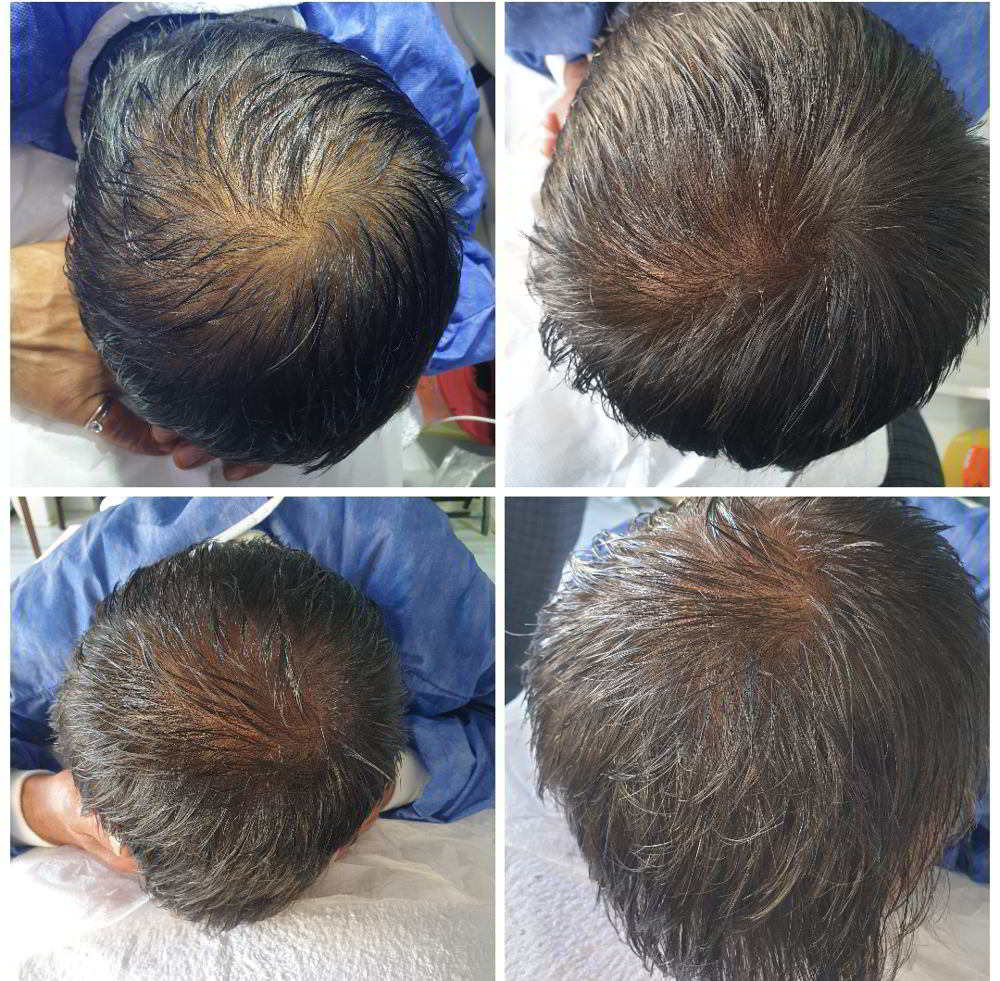
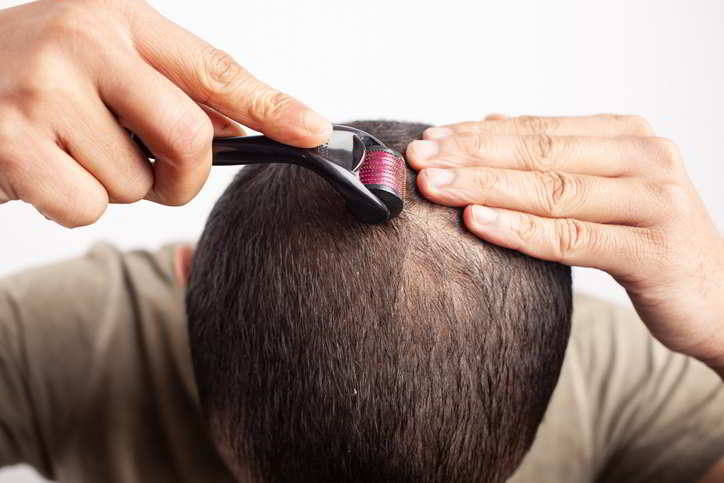
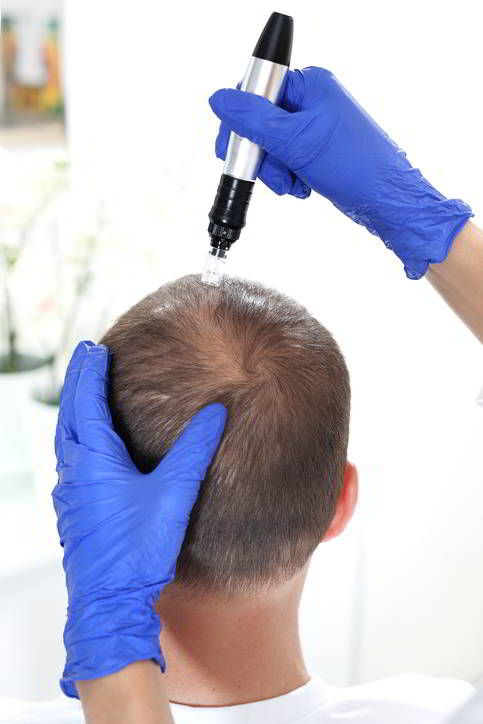
Scalp Microneedling
Microneedling to target hair growth
Microneedling involves the use of a skin roller with small needles that causes minor skin wounds in order to regenerate the health of hair follicles.While used as an anti-aging treatment, microneedling is also an effective method of treatment for hair loss. Evidence also shows that it helps in recovering from alopecia areata. It has also been found to thicken hair that is thinning as seen in androgenic alopecia or male pattern baldness.
Microneedling may also promote the absorption of products used to treat your hair loss, such as:
- Minoxidil (Rogaine)
- topical steroid
- platelet rich plasma
One studyTrusted Source in particular explored the potential benefits of microneedling when used with a topical corticosteroid to treat alopecia areata.
Hair loss products
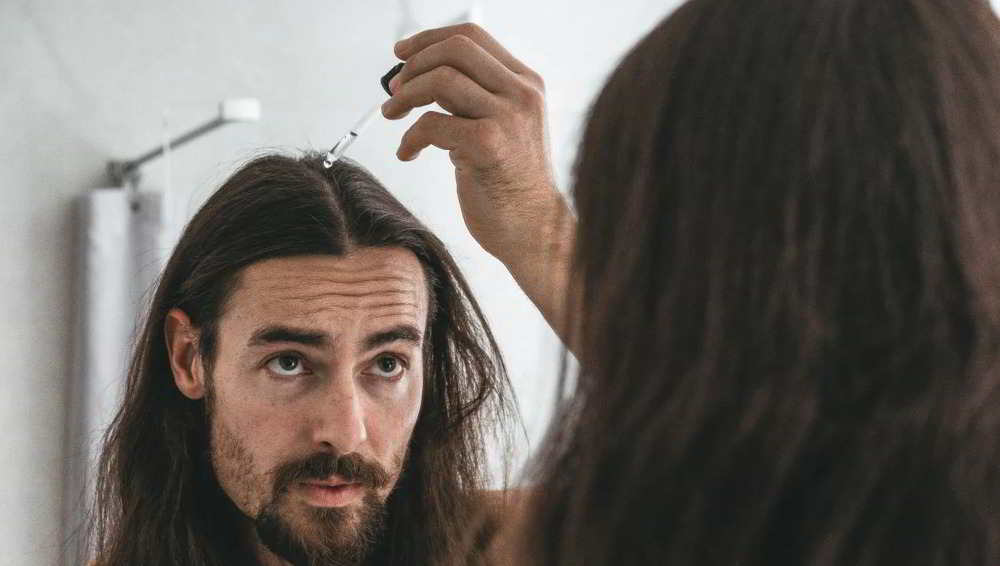

Clinically proven medication

